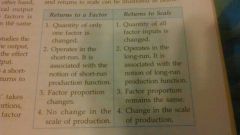![]()
![]()
![]()
Use LEFT and RIGHT arrow keys to navigate between flashcards;
Use UP and DOWN arrow keys to flip the card;
H to show hint;
A reads text to speech;
20 Cards in this Set
- Front
- Back
- 3rd side (hint)
|
Cost of production depends upon...? |
1. Input prices 2. Physical relation between inputs and outputs |
$ + <3 |
|
|
Theory of production |
Study of relationship between inputs and outputs |
<3 |
|
|
Theory of costs |
A study of relationship between output and cost of production. |
Diff <3 |
|
|
Compare production in layman terms and in economic terms. |
Layman terms - Creation of material or tangible goods. Economic terms - Act of making goods/services thereby adding utility. |
Make stuff Create utility |
|
|
Production function |
Functional relationship between inputs and outputs. Qx = f ( labour, capital) |
<3 |
|
|
Important points about production function |
1. Flow concept 2. Physical terms 3. Depends on state of technology |
Watch body robot |
|
|
Implication of production function |
It shows max quantity of a commodity that can be produced per unit time with the given amount of inputs, when the best production technique available is used. OR It is the min amount of inputs required to produce a certain level of output with use of best available technique of production |
Max min |
|
|
Short run |
Period of time during which the amount of some inputs called fixed factors cannot be changed. |
Fixed |
|
|
Long run |
Period of time during which all factors of production can be varied. |
All factors |
|
|
Short run production function |
A situation when only one input is variable and all other inputs are assumed to be constant. [Returns to a factor] |
|
|
|
Long term production function |
A situation when all inputs are used in production and are changed simultaneously in the same proportion. |
|
|
|
Total physical product AKA total returns |
Total amount of a commodity produced during some specific period of time by combining a particular quantity of a variable factor with a given quantity of a fixed factor. |
Total when little bit of variable with fixed. Watch |
|
|
Average physical product AKA Average returns |
Average product of a variable factor refers to output per unit of that variable factor. |
AP (L) = TP (L) / L |
|
|
Marginal physical product AKA marginal returns |
Change in total product resulting from one additional unit of a variable factor. |
MP (L) = Change in TP / Change in L |
|
|
Returns to a factor |
Change in output when quantity of one factor is increased while others remain constant. Three situations : 1. Increasing 2. Decreasing 3. Diminishing |
|
|
|
Law of variable proportions |
The law of variable proportions states that as more units of a variable factor are applied to a given quantity of a fixed factor, total product may increase at an increasing rate initially, but eventually increase at a diminishing rate. |
Up first down later |
|
|
Assumptions of law of variable proportions |
1. State of technology is constant 2. Some inputs are fixed and others variable 3. Technology can change variable inputs at varied proportions. ( not fixed ) 4. All units of variable factor are homogeneous. |
Robot constant Fixed + not fixed Variable not fixed Homo |
|
|
CAUSES - 1. Increasing returns 2. Diminishing returns 3. Negative returns |
1. (a) Full utilisation of fixed factors (b) Division of labour 2. (a) Distrubing the optimum proportion (b) Imperfect substitutablity 3. (a) Overcrowding (b) Management problems |
|
|
|
Returns to scale |
When all inputs are changed in the same proportion then - change in scale of production. Change in output due to change I'm scale of production is the law of returns to scale |
|
|
|
Differences between law of variable proportions and returns to scale |

|
|

